ImaHima in Montag newspaper (translated from Swiss German) (March 11, 2002)
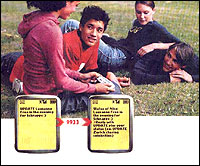
Where are your friends right now?
Locate your friends and find people with common interests using your handy!
ImaHima is a service imported from Japan that should make this possible in Switzerland.
An Indian guy living in Tokyo has just been dumped by his girlfriend. He asks himself, “I wonder which of my friends are hanging out somewhere nearby.” And he starts to think of ways to find new friends.
Neeraj Jhanji (that’s the name of the poor guy in our story) was thinking one step ahead of the rest of the bunch back in 1999. This is when he started developing his iMode Service – imaHima. With this service, mobile users can exchange information about their actual location and their actual availability.
In Japanese, “imaHima” means “Are you free now?” More than half a million people use imaHima in Japan – and the numbers are still growing. So Mr. Jhanji has become quite in demand! imaHima is available on all of the big Japanese mobile operator networks and AOL is the company’s main investor.
Are You Free Now?
imaHima has been up and running for a few weeks now in Switzerland. Luckily no attempt has been made to translate “imaHima” into Swiss German – in cases such as this, some technical and cultural adaptation is always necessary. In Japan, imaHima is running mainly on iMode, but also on WAP and preparations are currently being made for FOMA, the first UMTS network.

To achieve a sufficient base of customers here, it was necessary to adapt imaHima to GSM and allow messages to be transferred via SMS. The dimensions of big urban areas in Japan are of a much larger scale than in Switzerland. That’s why, localization played a much more important role in Japan than it does here. Swiss imaHima users just manually enter their location – the city or place actually occupied. It seems that this is enough for spontaneous meetings.
The Swiss service differs from the Japanese Service in terms of features as well, because in Switzerland much more focus is given to sub-communities: people of common interests (called “clubs” in imaHima terminology.) It is assumed, that people will use the service with their existing friends in addition to finding new ones – but this is in the end still an open question and not predictable in such an early phase.
Relatively Simple and Useful
Anybody who has a mobile phone that can send SMS can be “imaHima.” Registration can be done either via SMS or via the imaHima WEB page. During registration, everybody must select a nickname and can remain anonymous if need be.
In the beginning, you should ask some of your friends to register as well so that you can have a base of acquaintances to start with. Once registered, you can create your own buddy list or join one of the clubs (TV, Dating, Fitness, Hockey etc.). Some of the clubs are operated together with third parties, which deliver content and information.
Using imaHima via short SMS commands is relatively easy and straightforward. An SMS containing: “ADD Michi” sent to the imaHima short ID 9933 will add Michi to your buddy list. With “SEND BUDDIES hey let’s go to the cinema” you can invite all the friends on your buddy list to go to the cinema tonight. Such “broadcast messaging” (one command send to multiple recipients) isn’t possible with the built-in functions on existing handsets so far. This is one of the big advantages of imaHima. It’s a pity that presently only one buddy list can be created, because it would be much more convenient to have different buddy lists for different types of buddies (friends, family, colleagues etc.)
Anyone who has you on his or her buddy list can provide you with an automatic inquiry by sending “UPDATE zuri who wants to have pizza?” In addition other imaHima users sending “FIND zuri pizza” can perform a key word search on people doing things related to pizza. So the door is open for anonymous chats.
The pricing system is a little tricky. In general users who “order” anything will be charged. ADD costs 19 Rappen, SEND BUDDIES costs 19 Rappen * the number of users on your buddy list. UPDATE costs 19 Rappen for you and 19 Rappen for everybody who wants to receive your notification. A single SMS costs less than a standard SMS via the mobile operator (still, 60% of revenues go into the pocket of the operator.)
When somebody uses the service it’s instantly reflected on the monthly bill! Young people, whose telephone bills are paid by their parents, could potentially love imaHima, and soon a prepaid solution will be offered. In addition, the buddylist is restricted to 10 buddies.
If the Swiss audience reacts similarly to imaHima as the Japanese did, than there should be adoption within the next 24 months achieving roughly 25,000 customers. In the first months the target is to attract a few thousand people to the service.
- Roger Zedi
ImaHima in Wall Street Journal (March 8, 2002)

Let Me Entertain You: With Mobile Phones, Users Can Get Their Kicks Wherever They Go
The Wall Street Journal (Europe)
Tuning In to Interactive Games, Movie Clips and Virtual Pets
(an excerpt)
About a century after their heyday, nickelodeons are making a comeback. Only now you don’t have to line up at the arcade. You carry your theater with you, invite your friends, start the show any time you like and often take part in the spectacle yourself.
That’s mobile entertainment – the world of wireless amusements, where you can watch your home team’s winning goal, listen to your favorite band’s latest hit, or play Trivial Pursuit with friends at a bar.
There’s no surround-sound or big screen in this pocket-sized theater, but mobile entertainment offers a lot that you won’t find at the movie house: a personalized array of amusements to enjoy alone or share with others, available whenever and where ever you want to start the show. All it takes is a mobile phone.
Looking East for the Next Big Thing in Mobile Technology
As is true with many aspects of the mobile-phone market, mobile entertainment is quite hot in the East, humming along in Western Europe and starting to roll in North America.
Seeing what consumers are enjoying in Japan can provide an impressively accurate crystal-ball view of what Europeans and Americans can expect soon on their mobile phones.
So what’s next? “The biggest craze here in Japan is ‘sha-mail ,’ which is peer-to-peer picture messaging.” says DC Collier, Tokyo-based senior strategy director for applications and services at PacketVideo Corp., a San Diego, California, company that helps put video on mobile devices. “Everyone knows about it.”
 Sending a sha-mail means sending a message with a postage-stamp-sized photo attached – from a party, a vacation, or perhaps your otherwise blind-date for Saturday night. An application called imaHima (are you free now? in Japanese) cross-pollinates the mini photos with dating services.
Sending a sha-mail means sending a message with a postage-stamp-sized photo attached – from a party, a vacation, or perhaps your otherwise blind-date for Saturday night. An application called imaHima (are you free now? in Japanese) cross-pollinates the mini photos with dating services.
Mr. Collier has taken photos of friends and stored them in his phone’s address book, so their smiles show up when they call his phone. “Your phone is a networked, digital camera,” he says. “Sha-mail is the thing I use the most.” The Japanese market already has a fair share of phones with cameras, and Java-based phones and games have likewise been available in Japan for some time.
Mobile-phone trends often take a bit longer to develop in Europe compared to Japan, notes Pekka Isosomppi, a Nokia Corp. spokesman. But camera-phones are already making their way to the Continent. Nokia’s 7650, due out in the second quarter will have a built-in phone. “You open it and it turns into a camera. You snap a photo and it prompts you to know if you want to send the photo,” Mr. Isosomppi explains. And just this week, Sony Ericsson announced its P800 with a built-in camera, due to hit the market in the third quarter.
Designed by Tokyo-based Dwango Co., the Java-, location- and weather-based game Samurai Romanesque has been a hit in Japan, according to Wireless Games, Playing to Win, a report from London research firm Ovum Ltd. Players assume the parts of warlords from the 15th to 17th centuries, but weather conditions are contemporary. So if it’s raining in a city where a player is based, trouble with damp gunpowder can be expected.
- Jeanette Borzo
ImaHima in Bisnes.fi (Finnish) (March 2002)

Heimokulttuuria Japanista
Keskustelijat: Pekka Lahteenmaki ja Neeraj Jhanji
Pekka: Toimitusjohtaja
Neeraj Jhanji, mika ihme on ImaHima?
Neeraj: ImaHima on japania ja tarkoittaa “Oletko vapaa nyt?” Japanissa puhelimeen vastataan yleensa tervehdyksella ja kysymalla ” ImaHima”. Perustaessani ImaHima-mobiiliyritysta ajattelin, etta puhelimen pitaisi kertoa, missa olet ja missa ystavasi ovat. Palvelun ideana on olla yhteydessa ystaviin ja jakaa kokemukset. Ihmiset voivat valita suosikkilistaltaan esimerkiksi olinpaikkansa, mielialansa ja ovatko he vapaana nyt. Sitten viesti lahtee heidan ystavapiirilleen.
P: Omaa “statusta” pitaa sitten muuttaa kerran paivassa tai ehka kerran parissa tunnissa, vai kuinka?
N: Kylla, meilla ei ole nykyisessa ohjelmaversiossa automaattista jarjestelmaa, joka ilmoittaisi olinpaikkasi, mutta kiinnostavia kokeiluja on meneillaan.
P: Myo suomalaisen PopSystemsin Iiikeidea rakentui yhteisojen valisen viestinnan ja mobiiliheimojen varaan. Yritys meni konkurssiin tana vuonna. Mita mielta olet heidan liikeideastaan?

N: Riippuu siita, miten he rakensivat yhteisoja ja miten he toteuttivat visionsa. Se ei ole selvaa minulle, joten vaikea sanoa. Yritykset onnistuvat ja epaonnistuvat monistra eri syista, mutta tiedamme, etta viestinta ja halu tavata muita ihmisia ovat keskeisia tarpeita. Emme toimi vain olettamusten varassa, vaan markkina on todellinen. Meilla on puoli miljoonaa maksavaa kayttajaa.
P: Olette lanseeranneet sms-pilottipalvelun Sveitsissa, mutta eihan Japanista voi tuoda mobiilipalveluita Eurooppaan, koska kulttuurierot ovat liian suuria.
N: Emme voi viis veisata eroista, mutta ihmisten tarpeissa on paljon samaa. Kyse on siita, miten kaytat mediaa.
P: Ovatko teini-ikaisten tarpeet samanalaisia ja Sveitsissa ja Japanissa?

N: Makrotasolla haluan uskoa etta teini-ikaisten tarpeet harmonisoituvat eri puolilla. Eroja on siina miten he ilmaisevat itseaan.
P: Mika on ImaHima-ryhman ideaalikoko?
N: ImaHiman kayttajilla on kaverilistallaan keskimaarin viisi henkea. Nama ovat siis ihmisia, joiden kanssa haluaa olla jatkuvasti kosketuksissa. Monet kayttavat palveluamme myos deittailuun ja haluaisivat kayttaa hakukriteereina ikaa tai sukupuolta, mutta emme tarjoa niita. Olemme yksi suosituimmista deittipalveluista, vaikka oikeastaan emma ole lainkaan deittipalvelu. Ironista.
P: Miten ansaitsette rahaa?
N: Bisnesmalleja on monta. Kiintean kuukausimaksun mallissa operaattorit maksavat meille 1-3 euroa kuukaudessa kayttajaa kohti. Toisessa mallissa kayttaja maksaa kaytosta, kuten SMS-palveluissa. Kolmanneksi saamme tuloja lisensoimalla teknologiaa muille yhtioille, kuten operaattoreille ja muille palveluntarjoajille.
P: Paljonko keskimaarainen kuluttaja maksaa kuussa ImaHiman kaytosta?
N: Sanosin, etta aktiivinen kayttaja maksaa noin 10-15 euroa kuussa. Tasta 1-3 euroa tulee meille ja loput operaattorille.

P: Teit juuri sopimuksen AOL:n kansaa. Milloin tuot palvelusi Suomeen?
N: Etsin kumppaneita taalta. Mietimme oikeaa markkinoille tulotapaa:suora yhteistyo operaattoreiden kanssa tai yhteistyo paikallisten mobiilisovellusten tarjoajin kansaa. Pitaa ensin tehda markkinatutkimusta. Jos asiat menevat hyvin, laajennamme tana vuonna ainakin joillekin tarkeille markkinoille Euroopassa.
P: Minka palvelun toisit tanne ensiksi?
N: Ehka Instant Messengerin tuominen mobiililaitteisiin saataisi olla jarkevaa. Toinen saattaisi olla kuvaviesteihin liittyvat palvelut, mutta se riippuu paatelaitteiden kehittymisesta. Tai sijaintiin perustuvat deittipalvelut. Naissa kaikissa saattaisi olla jarkea ja joku tekee ne joka tapauksessa – me tai joku muu. En kuitenkaan pettyisi, jos naita palveluja jo olisi tai joku muu tekisi ne.
P: Suomessa on tuntuu olevan vallalla jonkinlainen epausko mobiilipalveluihin. Mita sanot siihen?
N: Epausko on luonnollista. Meidan pitaa menna eteenpain ja edistysta ei itapahdu ilman muutosta. Toimitaan jatkossa viisaammin.
Intialaissyntyinen Neeraj Jhanji perusti ImaHiman Tokiossa vuonna 1999. Nyt matkapuhelinpalvelulla on 500 000 aktiivista kayttajaa paaasiassa DoCoMon, JPHonen ja KDDI:n matkapuhelinverkoissa. ImaHimaan on sijoittanut muun muassa AOL Time Warner.
ImaHima in Blick (translated from Swiss German) (January 31, 2002)
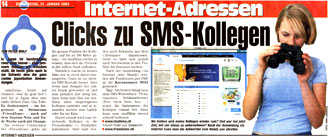
Internet-Adressen: Clicks to SMS Colleagues
We often lament that Switzerland is far behind Japan in terms of the mobile world. But a new light has been cast on the once gloomy situation, as the Swiss public now has access to one of the coolest Japanese mobile applications available.
In Japanse “imaHima” means “Are you free now?” and in Japan ImaHima, Inc. has more than half a million fans. The big advantage of imaHima’s service (compared to similar offerings like Swisscom’s “Friendzone”) is that it’s not only available through Swisscom, but also through the Sunrise Mobile Network (and mobile carrier Orange will join at the end of this week.) Another difference is that Friendzone depends on one’s exact geographic position (within 100 meters) while with imaHima it’s sufficient to know that your friends are in the same city.

Of course for communication limited to just two friends, direct SMS contact is enough. But lets say your tutor cancelled your lesson and you suddenly have some free time. Just use imaHima to inform your registered friends about your current status, then hook up with someone who’s free for shopping or cinema. The first step is to add your friends to your buddy list. But soon new friends from cyberspace will become available to you. This is possible because you can search other users’ profiles directly for key words which match your interests! After registering (via web or handy) imaHima commands should be sent via SMS to 9933.
- Peter Wolf
ImaHima mentioned in Howard Rheingold’s book “Smart Mobs” (December 1, 2001)
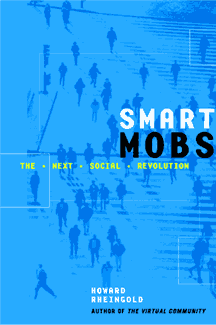

“I looked at my phone and the answer seemed obvious,”
(an excerpt)
In the fall of 2001, I visited the office of ImaHima in Tokyo’s ultra-modern Ebisu Garden Place Tower. ImaHima founder, Neeraj Jhanji, was the only person in the office on a Saturday morning. The DoCoMo skyscraper I had visited the day before was visible through the window. Neeraj, twenty-nine, a native of India, remained in Tokyo after a stint with an international consulting firm. One sunny Saturday, walking alone in one of Tokyo’s most popular and crowded districts, he wondered if any of his friends were nearby. “I looked at my phone and the answer seemed obvious,” he told me. Even without GPS location awareness, it would be possible to use the Internet to coordinate locations. At the time I spoke to Jhanji, ImaHima had won the prestigious Prix Arts Electronica, had been adopted as an official i-mode site, and had gained 250,000 users with a median age of twenty-five. ImaHima was planning to launch in European markets by 2002.
Jhanji showed me how the service works. When you join, you fill out a profile and set up a buddy list similar to the kind used with Internet instant messaging; each person must give permission before someone else can know automatically where they are. You also list your favorite places. When you select the “update” link on your mobile’s ImaHima menu, everyone on your buddy list knows, for example, that you are within a few blocks of Shibuya station and are free for lunch.
The just-in-time, just-in-place matchmaking service for strangers, an intriguing aspect of ImaHima, is also where the most caution is required. With young women in Tokyo being targeted on the street by solicitors for “hostess bars,” no service could hope to attract any females without strict controls–nor would DoCoMo’s strict policies allow a service to become a lucrative official i-mode site. “You can search through the list of your friends,” Jhanji told me, “or you can ask permission to contact a stranger whose profile matches your request and who is nearby. But if you request permission to communicate and the other person denies your request, the system blocks you from communicating with that person again.”
- Howard Rheingold
ImaHima in Newbiz (French) (October 2001)

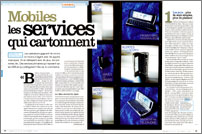 Mobiles les services qui cartonnent
Mobiles les services qui cartonnent
Les operateurs gagnent de moins en moins d’argent avec las appels classiques. Ils se rattrapent avec les jeux, les sonneries, etc. Des services primaires qui reposent sur les SMS et qui prefigurent l’ere du m-commerce.
(an excerpt)
Le chat de communaute: il est plebiscite par les ados «Non a l’amendement anti-free parties» Debut juin, 50 000 fans de techno ont manifeste sous ce slogan…en restant chez eux! Ils ont rejoint une communaute de chatteurs par telephone, baptisee «Casse pas ma rave», en s’inscrivant gratuitement sur freever.com. Puis ils ont envoye une petition par SMS a plusieurs deputes!
Chat et SMS: le mix seduit les ados. Apres cinq mois d’existence, Freever compte 360 000 utilisateurs et table sur un chiffre d’affaires de 10 millions de francs en 2001. Son partenariat avec les trois operateurs francais et sa «plate-forme technique unifiee» permettent ainsi a deux collectionneurs de timbres de parler ensemble,meme si l’un est chez Bouyges et l’autre chez SFR. Un reel atout dans la perspective de services fondes sur la geolocalisation (lire le modulen°6). Exemple: un passionne de papillons veut diner avec un congenere? Il envoie un SMS a tous ceux qui se trouvent dans un rayon d’un kilometre. Farfelu? Non. Au Japon, la societe ImaHima, qui a fait de ce service sa specialite, revendiquait 320 000 inscrits en juin dernier.
ImaHima nominated for Prix Ars Electronica (September 2001)
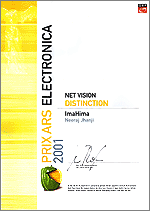
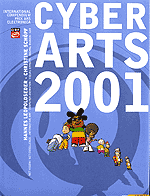 NET VISION / NET EXCELLENCE
NET VISION / NET EXCELLENCE
“ImaHima” is a location-specific application for the Japanese I-Mode standard, which makes the principle of newsgroups mobile and displays to the user people with the same interest and friends nearby on his mobile phone.
ImaHima, Inc. is a Japanese company founded in 1999 focused on providing location-based community services for mobile phone users. The company provides its service to all Japanese Mobile Operators – NTT DoCoMo, JPhone, KDDI – and has been appointed last year as an official service provider for NTT DoCoMo. The service is unique in Japan and runs on Japanese iMode, WAP platform version 1.1 for KDDI and on a standard web browser. Since its launch in December 1999 on iMode, imaHima has grown to over 250,000 users naturally and receives over a million page requests a day. Within the last 6 months, imaHima experienced a customer growth of more than 200% compared to the Q2 2000 customer base.

With AOL as partner and investor, imaHima is presently accelerating its business development in Japan and the European expansion. For the European market, the company plans to launch a product supporting WAP, iMode, WEB and SMS as communication platforms. “imaHima” is the Japanese expression for “are you free now?”

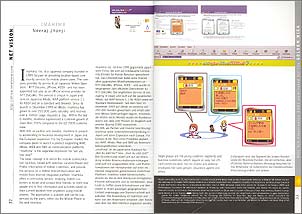
The basic concept is to utilize the mobile communication facilities, linked with selective Location-Based and Profile Information of mobile customers, and provide the services on a mobile telecommunication and mobile-fixed Internet integrated platform. ImaHima offers a community service, enabling mobile customers to locate and contact their friends, to meet new people and to find information and activities based on their current location from anywhere using mobile phones. The application is scalable and can be customized by the users, either via the Mobile Phone or the web interface.
Target groups are the young customer segments and business customers, which require an easy but efficient communication tool for mobile and external employees like sales people, insurance agents and others.
Neeraj Jhanji (RI), aged 29, first conceived the need for location-based mobile group messaging services in March ’99. Before founding ImaHima in December 1999, Neeraj worked as a senior consultant in e-commerce strategy for Accenture in Tokyo, prior to which he was the Fujitsu Asia-Pacific Scholarship recipient for the MBA program conducted jointly by University of Hawaii, JAIMS and Hitotsubashi University. He previously worked in technical and consulting roles for Siemens and Unisys. He holds an undergraduate degree in Electrical Engineering from the University of Delhi and is fluent in English, Hindi and Japanese. Neeraj’s childhood dream is to fly planes.
imaHima at Prix Ars Electronica Cyberarts (September 3, 2001)
imaHima is a Golden Nica nominee under “Net Vision” category at Prix Ars Electronica Cyberarts competition 2001 in Linz, Austria for its unique mobile, location-based social networking service. (segment starts at 2:25) (in German)
ImaHima in Koukoku magazine (Japanese) (August 15, 2001)

Prix Ars Electronica 入賞者に訊く: 知らないうちに受賞していました
広告
An interview with a Prix Ars Electronica winner / I didn’t know that I won an award!
毎年、オーストリアのリンツで発表される世界最大の電子芸術コンテスト、プリ・アルス・エレクトロニカ。今年、新たに開設されたネットビジョンという部門に、あるユニークな存在が日本から準大賞に選ばれました。その名は、イマヒマ。携帯電話上でのメッセージング・ツールです。携帯電話によるコミュニティー・サービスという、思い切り日本独自のメディア環境が、なぜ、アートとして注目を浴びることになったのでしょうか。このバックストーリーを探るため、イマヒマを立ち上げた張本人のニラジ・ジャンジさんにお話を伺ってみました。
岡田智博: 受賞おめでとうございます。
ニラジ・ジャンジ: 実は僕、アルスエレクトロニカって知らないのです。ある日、いきなり「あなたは受賞しました」とか書かれたメールが届いたので、また何か詐欺っぽいスパムメールだろうと思っていた。でも、そんなメールが何度か来るうちに、ああ、受賞してしまっていたのかと理解したのです。
岡田: でも、誰かがエントリーしないと選ばれないですよね?
ジャンジ: 日本の携帯通信事情をやり取りしている国際的なメーリングリストがあるのですが、そのモデレーターの一人から、「何かに推薦したいので、イマヒマの情報が欲しい」というアプローチがあったのは覚えています。それっきり何の音沙汰もなかったのですが、どうやらエントリーされていたみたいです。そんなことなので、なぜ受賞したのかさっぱり分かりません。
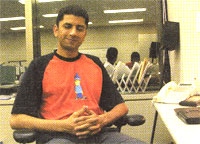 岡田: イマヒマをアートだと思いますか
岡田: イマヒマをアートだと思いますか
ジャンジ: 僕はそうは思わない。コミュニケーションのための道具です。でも、そのコミュニケーションを豊かにするために、アート的な部分はとても重視しています。だから、イマヒマを育てるにあたって、インターフェイスやその上でのキャラクター、世界観のイメージを豊かにするような画を描いてくれる、渡辺恭子さんという人に出会ったのです。彼女の画がイマヒマをいい感じのものにしてくれています。
岡田: イマヒマを始めたきっかけは?
ジャンジ: 僕自身の話からすると、インドのデリー大学で電気工学の勉強をしていました。そのころ、米国でMBAを習得したいと考えていたのですが、お金が無くて悩んでいました。そのとき富士通が日本経営修士プログラムというものをハワイ大学で開講していて、招待留学生を募っていることを知ったのです。それに応募したら合格してMBAをとりました。その際、インターシップで東京のアンダーセン・コンサルティングに行き、そのまま就職したのです。
就職した後のある休日、僕は渋谷のハチ公前の交差点に居ました。僕は一人ぼっち、でもこのたくさんの人波の中に知り合いが居るかもしれない。もし知り合いが居ることが分かれば、すぐに声を掛けて遊びに行くのに。そのときから、友達が何をしているのかいつでも分かり合えるツールがあったらいいなと思い始めたのです。

岡田: イマヒマは現在、どのようなものになっているのですか?
ジャンジ: まず、登録している人同士が、今、どこで、何をしているのかを伝え合う、メッセージング・ツールとしてのイマヒマがあります。もうひとつは、チャット機能を持った新しいバージョンのイマヒマです。これは独自の技術でパケット通信量を他に比べて極度に減らすことに成功したので、インターフェイスにも、おさいふにもやさしいツールになりました。
最初の頃、ユーザーの数が少なかったということもあって、オープンにユーザーの伝えている情報を見ることの出来るサービスを提供していました。なので、よく出会い系サイトに間違えられていたのですが、実をいうと、出会い系はあまり好きではありません。それよりも僕は、家族や友達としっかりつながりあえるための道具として、携帯があればと思っています。そこで今は、グループを作って、そのなかで伝えあうというクローズドなサービスにして、少しでも心が通うコミュニケーションを実現しようと考えています。
岡田: その考え方はインターフェイスや宣伝材料などにも出ているように思えますが。
ジャンジ: そうなのです。恭子さんにデザインの相談相手になってもらったのも、僕の気持ちとあった画だったからということがあります。もともと、彼女は立体造形をしている芸術家なのですが、日本に古くからあるようなやわらかくてやさしい感性を持った画を描いてくれ、その画をもとにいろいろなイマヒマのためのアイディアも出してくれています。
ジャンジさんのコミュニケーションへの独特の眼差しが、イマヒマに独自の世界観をもたらしているようです。モバイルは大事な人との絆を深めるためのツール。イマヒマをアートとしてみなした人は、ドットコム漬けの毎日では忘れてしまいがちな、大切な想いを実現しようとしているジャンジさんの姿勢に、文化としての美学を感じ取ったように見て取れます。
imaHima 携帯電話用コミュニケーションツール
1999年よりサービスを開始した、Webブラウザー機能を搭載した携帯電話(i-modeやezweb、J-SKY)上でのコミュニケーションツール・サービス。登録ユーザー間によって作られたサークル内で、ユーザー任意の打ち込みによる位置情報やユーザーの状態が、ウィットに富んだショートメッセージとアイコンによるインターフェイスでやり取りすることが出来る。新規サービスとして、Java携帯向けのパケット通信量を著しく抑制することに成功したリアルタイムチャットimaHima chatをリリースしている。imaHimaはNTTドコモとKDDIの公式コンテンツになっており、それぞれ、以下の方法でアクセスできる。
【iモード 公式サイト】「iモードメニュー」→「iメニュー」→「メニューリスト」→「辞書/便利ツール」→「⑧imaHima」
【EZweb 公式サイト】「EZメニュー」→「EZインターネット」 →「コミュニケーション」→「imaHima!」
【J-SKY】URL入力 http:///www.imahima.com
全体では約30万ユーザーが登録している。ニラジ・ジャンジは上記のサービスを提供しているイマヒマ株式会社の代表である。
※上記につきまして、現在のアクセス方法とは異なる場合があります。
